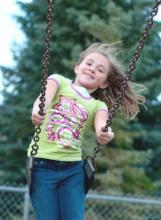
Children through the years have enjoyed swinging, whether on the playground, at the park, or in the backyard. The back and forth motion of the swing can be both relaxing and exciting depending on the child’s play motivation. The sensations of flying and falling make swings one of the most popular pieces of equipment on the playground.
There are many types of swings suitable for children. Probably one of the oldest swings is the rope swing, which can be tied to a tree branch and have a knot in the rope to sit on or a board attached for a seat. Traditional swings generally hang from two ropes or chains with a seat attached. Tire swings can be hung vertically from a single rope, hung horizontally from a crossbar using multiple ropes or chains that allows for a circular rotation, or hung from a crossbar using two supports to create a back and forth swing. Very young children can be swung in toddler or tot swings that fully support their bodies. Playground manufacturers continue to develop adaptive swings to make swinging accessible to children with special needs.1
Besides being an enjoyable activity for children, research supports that swinging is very beneficial for physical, social, and cognitive development for children and can also be used in therapeutic situations. Physically, children develop gross motor skills, including locomotion, balancing, and body coordination, as they run and jump into swings, push others, develop pumping motions, and jump out of the swings. They also develop fine motor skills including hand, arm, and finger coordination, grip strength, and circling motions of their arms and legs.2
Although swinging can be a solitary activity, children usually enjoy swinging together. Since there are usually a limited number of swings available, children learn cooperation, taking turns, and sharing. Swinging can also prompt competition between children to see who can swing higher. The social and emotional development of children is enriched by the children’s social interaction with others. Younger children especially enjoy the interaction with an adult or older child when being pushed in order for them to be able to swing. Once the child has achieved the skills to swing on his own, scaffolding is no longer necessary.
Swinging can aid cognitive development as children engage in dramatic play using their imaginations to pretend to be pilots or astronauts, for example. This pretend play helps children create a mental picture in their minds of an object that is not really there.
Sensory stimulation is especially affected by swinging. For children to successfully acquire the necessary skills to respond to movement and gravity, they must develop their vestibular coordination, proprioception, and visual perception. Swinging helps in the development of these skills. Vestibular coordination involves the inner ear and senses movement of the head to interpret speed and direction of movement. The proprioceptive system receives information from the muscles and joints and aids in balance and body awareness. Visual perception is also developed as children swing and learn to interpret what they see while moving. Children who have difficulty with sensory integration can be helped with therapists who use various swinging activities to stimulate the senses.3
The ability to swing independently follows a progression of overlapping swinging skills. Beginners need assistance to sit on the swing as well as move, and they prefer swinging at lower heights. As children get older, they can lift themselves onto the swing as well as propel themselves without assistance. Advanced swingers have good balance and have learned the smooth and fluent movements necessary to elevate them to higher heights. The successful coordination of bending the torso and pumping the legs back and forth gives children confidence, and children often try risk taking behaviors, such as jumping from the swing while in motion or standing on the swing.4
- 1. Frost, Joe L., Pei-San Brown, John A. Sutterby, Candra D. Thornton. The Developmental Benefits of Playgrounds. Olney, MD: Association for Childhood Education International, 2004. pp. 167-201.
- 2. Frost, Joe L., Pei-San Brown, John A. Sutterby, and Debora Wisneski. “Function and Value of Swings: The Benefits of Playground Swings.” GameTime. < http://www.gametime.com/pdf/frost-swings-final.pdf > 22 March 2012.
- 3. Op. cit., Frost, Brown, Sutterby, and Thornton.
- 4. Op. cit., Frost, Brown, Sutterby, and Wisneski.

